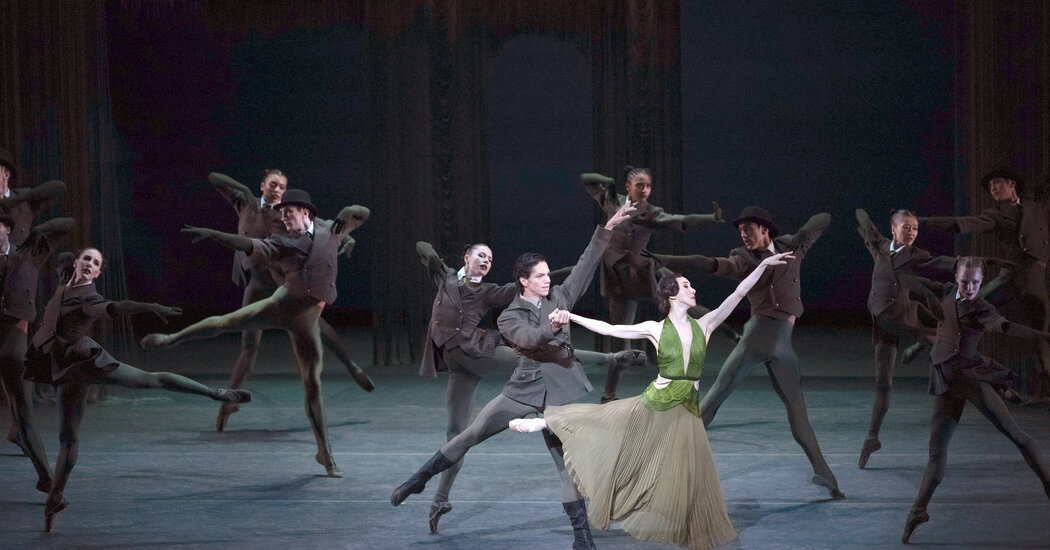American Ballet Theater’s fall season, which just wrapped up at Lincoln Center and included Misty Copeland’s classy farewell performance, provided a few reminders. A new ballet isn’t always fresh. An old ballet doesn’t have to be dusty. And when it’s clear that money spent on a new ballet carries more weight than imagination or vision, there is a problem. Fresh is a quality that cannot be taught or bought.
This was the case with the bewilderingly punctuated “Have We Met?!,” a world premiere by Juliano Nunes. Programmed as part of Ballet Theater’s 85th anniversary season — a three-week run at Lincoln Center that began with a bold Twyla Tharp triple bill — “Have We Met?!” was a busy, thin affair told over two centuries. Each featured a pair of dancers; in the opening-night cast, Hee Seo and Isaac Hernández, and Catherine Hurlin and Daniel Camargo.
The relationship between Seo and Hernández is doomed in the first half, which takes place in 1928 under a cold, steely Manhattan Bridge. In the second, with Hurlin and Camargo beneath the Brooklyn Bridge, it is 2038 and seemingly the same couple — or their souls — reunite. In each section, the bridges have a way of floating above the stage. Constructed by Youssef Hotait, who also designed the costumes, they are made of pieces of fringe and act, for a moment, as distraction from Nunes’s underwhelming choreography — more muscular than musical — and sophomoric storytelling.
As dancers whizzed back and forth across the stage to a blandly cinematic score by Luke Howard, the lifts came and went. This was a ballet full of shapes, but little texture. Hernández, whose acting abilities can survive a flimsy part, was a jolt of energy as his character experienced a mental breakdown. The reasons for it were vague, but the tension and torment overtaking his body were not. He was affecting.
Mercifully there were other ballets in this packed season with mixed bills that jerked your eye and mind from here to there. On the same program as “Have We Met?!” were two other works created for the company, Alexei Ratmansky’s male-dominant “Serenade After Plato’s Symposium” and George Balanchine’s masterpiece “Theme and Variations.” In “Theme,” choreographed in 1947, the women were stronger than the men, including a regal, though at times less than ideally assertive, Chloe Misseldine opposite Camargo.
But the men, firmly in the spotlight in “Serenade,” brought it to a more vibrant place than it occupied in its 2016 premiere. Set to a Leonard Bernstein score, the dance is both sensitive and virtuosic. But it can also trickle into will-it-ever-end territory with scenes that, in previous performances, veered into wistful male posturing.
This time, it was fresh — a more subtle expression of love generously anchored by the principals Herman Cornejo and James Whiteside, a dancer who has endured major injuries to become, in this late phase of his career, a lighter, more open version of himself. Patrick Frenette, sultry and stoic, was wonderful; Calvin Royal III filled space with polish and sweep.
And Takumi Miyake was spectacular, his body breezing across the stage with high, floating leaps and tight, concise turns. His warmth makes his elegance all the more genuine. (Jake Roxander has that quality, too, and was a particular joy in Tharp’s “Push Comes to Shove.”)
The early performances of Tharp’s ballets were unsteady, with dancers unable to grasp how gravity plays with air; once they did, they were more nuanced, more confident, more capable of being themselves. Those qualities were more than evident in another Tharp work, tucked on a later program: “Junk Duet” (1998), set to music by Donald Knaack from “Known by Heart.” Breanne Granlund and Cornejo showed their classicism and humor in a witty, competitive duet that worked like a restorative tonic to “Grand Pas Classique,” a dull crowd-pleaser by Victor Gsovsky.
While “Junk Duet” is a game of one-upmanship, “Grand Pas Classique” (1949)— with its virtuosic challenges placed on repeat — is like a competition dance. SunMi Park, paired with Michael de la Nuez, who seemed out of his depth, was radiant, smoothing over challenging choreographic passages with exactness and ease. Her technique is powerful, but she never takes advantage of it. Park, still a soloist, is a dancer who glows in any ballet, but this lifted her higher — just as she lifted the dance.
There were more vintage classics rounding out the season — “Les Sylphides,” “The Kingdom of the Shades,” Act III of “Sleeping Beauty” — as well as Antony Tudor’s foray into comedy, “Gala Performance” (1938), which reinforces the idea that, with humor, less really is more. But Misseldine, as the Italian Ballerina, was a riot. Sinking into a deep plié with her wrists flexed before her, she looked like a preying mantis.
The company also brought back Agnes de Mille’s “Rodeo” (1942), the hit ballet she made a year before choreographing “Oklahoma!” on Broadway. This was a test of a dancer’s power: What does it mean to be fresh in a narrative, Americana ballet more than eight decades old? Choreography is a mysterious, alchemical art, a conversation between the past and the present.
In “Rodeo,” set to a score by Aaron Copland, our heroine is a Cowgirl — a brash, independent tomboy who struggles with traditional notions of femininity, her desire for the Head Wrangler and her friendship with the Champion Roper. Cranky and wild, stubborn and lonely, the Cowgirl is a role — as is “Rodeo” itself — that could linger past its expiration date. But its sincerity prevailed.
As the Cowgirl, the principal Skylar Brandt was sweet and self-assured opposite Roxander — zestful as the Roper — but lacked a certain pathos. Granlund, a soloist whose face has traces of the strong will of a 1940s actress, was fully inside of her Cowgirl, glowering in all the right places and riding her horse — an invisible one — at breakneck speed, buckling and lurching with vivacity. She was marvelous.
And there was another Cowgirl in the mix, one with a passionate inner life. Zimmi Coker, a member of the corps de ballet, somehow, was the role.
As she gradually and fretfully lived through the pain of trying to figure out who she was — a Cowgirl in a man’s world — she threw herself into every aspect, embodying heartache, yes, but also her love of the land and the sky above. She showed how the ballet isn’t just Americana, but about America.
Flying through the air on her horse, her red braid flopping in the breeze, Coker was fearless and funny. Her attention to shape and movement — to dancing to the fullest, to acting like a girl dressed as a boy while undergoing strange feelings and the pain that comes with them — was touching.
When she appeared for the final scene, a dance at the ranch house, wearing her sad yellow dress with pride, it was clear that the Champion Roper, an adorably forthright Joseph Markey, would be her one and only before she knew it herself. But when she finally grasped the truth, Coker took her Cowgirl to another dimension, dancing with spellbinding, unrelenting joy. She was the epitome of fresh.
Gia Kourlas is the dance critic for The Times. She writes reviews, essays and feature articles and works on a range of stories.
The post At Ballet Theater, Trying to Make the Past Feel Fresh appeared first on New York Times.




